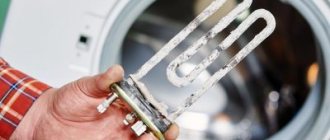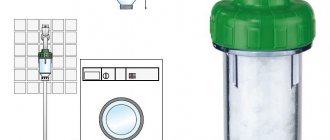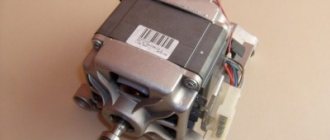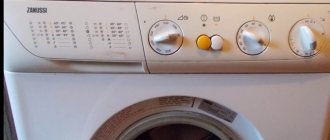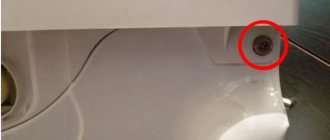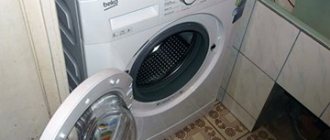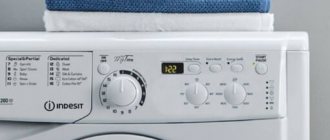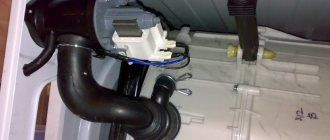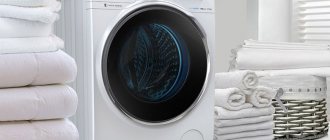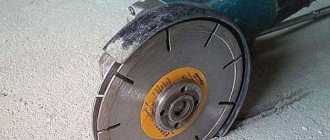The heating element in the washing machine is responsible for heating the water for high-quality and efficient washing. Unfortunately, it most often fails. There are two main causes of failure: short circuit and scale. As a result of a short circuit, the heaters or their contacts burn out; when scale occurs, the element overheats and fails.
After reading the article, you will learn how to clean the heating element of a washing machine from scale.
Causes of scale
First you need to make sure that cleaning is really necessary. To do this, you need to partially disassemble the washing machine and look at its internal parts. In this case, some knowledge of technology, or at least the help of the Internet, will not be superfluous, since each model has its own design nuances.
If you notice a hard coating on the surface of the heating element that cannot be removed with a rag, this means that the machine really needs cleaning.
Causes of scale:
- As already mentioned, the washing machine receives hard and dirty tap water.
- The presence of various chemical components in cleaning products.
- Frequent operation of the machine in intensive mode.
Cleaning the filter
To avoid breakdowns of household appliances, it is imperative to clean the filter, as well as the hoses. There should be no blockages, otherwise it could cause a breakdown.
Sequence of work:
- Before you start cleaning the filter from dirt, you should place a rag under the device to prevent water from spreading throughout the bathroom.
- You will also need some kind of container to drain the water from the hose. The latter is located behind the panel that covers the filter.
- Lower the hose to the bottom of the container. The filter can be found at the bottom of the machine in a special small hatch.
- Open the hatch.
- Wait until the liquid drains completely from the hose, then remove the filter by turning it counterclockwise.
- The filter lends itself, but you can’t take it out right away; you should wait a little, holding it so that the remaining liquid drips onto the flap.
- Inspect its impeller, remove all dirt from it and put it in place.
- Don't forget to clean the base where the filter is inserted.
So, the cleanliness of the washing machine is the key to its long service life . You just need to take care of your assistant, arrange for pollution prevention at least once every six months, and then problems will be avoided. If a sediment has already formed, you can use the above methods, which will return your home appliances to their former shine and prevent them from breaking.
Save
Cleaning a tubular electric heater
The heating element is 10 times more susceptible to breakdowns, which often arise precisely because of scale. Moreover, this problem is getting closer with every wash. And then the moment comes when, due to a large accumulation of scale, the automatic program cannot even start the wash. It will become clear that the electric heater has failed when the machine suddenly turns off in the middle of operation. The problem is clear, so we need to start fixing it.
Cleaning with citric acid
“Limonka” is very often used for cleaning scale. The amount required for cleaning is determined by how heavily “overgrown” the tubular element is. A machine with a 5 kg load of laundry will require approximately 5 sachets of citric acid. One must be poured into the drum, and the rest into the powder compartment. Then select the washing mode at 95 degrees temperature.
At the end of the wash, the scale will come off along with the water. The only thing you have to worry about is that it doesn’t clog the drain hose, otherwise you’ll have to puncture it.
This cleaning method can be used no more than once every 2 weeks.
Cleaning with acetic acid
Cleaning with vinegar is a less popular method, but still relevant. It is worth remembering that this acid is much more aggressive than the previous one, so you need to be extremely careful not to damage the rubber parts of the machine. But this option will cope with shadow deposits much faster.
Just 50 ml needs to be poured into the powder compartment to cope with the problem. But all this is done only at your own peril and risk, since you cannot predict what the results will be.
How to get the heater
For front-loading washing machines, the element can be located in both the front and back.
Try to visually determine where the heating element is by inspecting the front and back panels. Usually it is hidden behind a wider lid.
To remove the element, remove the CMA panel.
Front Panel:
- Remove the top cover by unscrewing the two bolts at the back.
- Pull out the dispenser tray by pressing the latch.
- Unscrew the control panel screws and lift it up.
- Remove the bottom cover, unscrew the screws there.
- Open the hatch door, bend the cuff, remove the metal clamp.
- Disconnect the wires of the electronic lock (UBL).
- Remove the front panel.
The heater in this case is located under the tank. You need to press out all the connectors leading to it, loosen the central nut and push it inward.
Take out the heating element.
To remove the back cover, you only need to unscrew the mounting screws to get to the element.
How to remove scale? To do this, remove the temperature sensor from the heating element and rinse it under running hot water. Remove the pieces of stone that are removed by hand. Do not forcefully scrape off the scale, otherwise you may damage the body.
- Take a two-liter plastic bottle.
- Cut off the neck and fill the container with hot water.
- Dissolve three to four tablespoons of citric acid in water.
- Place a heater there.
- Leave it for a day.
The acid breaks down the components of the water stone. After that, all you have to do is remove the coating - and you will get a clean part.
Then install it in place and do not forget about prevention.
Scale prevention
Prevention is divided into two types:
- Physical.
- Chemical.
Physical prevention is a special device that has several magnets installed in the hose through which water is supplied. Due to the fact that magnets create resonance and thereby change the structural formula of water, the formation of insoluble sediment is prevented, even when washing at high temperatures.
Chemical prevention involves using a special additive during washing. Thus, the insoluble precipitate still dissolves. There are quite a lot of such products on the market, the most common is Calgon, but there are others that contain sodium tripolyphosphates. It is added along with the powder.
To avoid tissue damage, it is best to use this product at idle speed and carefully read the instructions before doing so.
Among other things, ordinary soda ash can soften water. But be that as it may, the main thing is to correctly indicate the proportions, otherwise cleaning the heating element of a household washing machine will be simply inevitable.
How to clean an automatic washing machine: advice from experienced service technicians
The water coming into our water pipes is by no means ideal. It can be too harsh, and smells of bleach, and has other impurities. In addition to this, we constantly stuff the washing machine with various chemicals. And our “washing machine” reacts dissatisfiedly to this, urgently demanding cleaning. She especially doesn't like the scale that appears. To find out how to clean an automatic washing machine correctly, we suggest reading the recommendations of service specialists.
Causes of pollution and their possible consequences
First, let’s make sure that cleaning is a forced and necessary action. And it doesn’t hurt to know what exactly needs to be cleaned. Let's take a look inside the machine, which has worked for quite a long time. It is highly likely that we will see a dirty coating on the surface of plastic and metal parts. It can be hard and contain minerals, so you can’t handle it with a rag or your hands.
The reasons for this problem may be the following:
The water coming from the tap is hard or dirty.
The powder contains too many chemical components.
The machine constantly operates in the “intensive wash” mode.
What’s especially bad is that many of the corners where dirt accumulates are difficult to reach. Try to clean them - your hand won’t fit there, and poking with something sharp is too dangerous. So more and more dirt accumulates, and then the machine can’t stand it and breaks down. And repairs cost a pretty penny. So why go to such extremes - it’s better to ask in advance how to clean the drum of the washing machine, its tank and heating element. By taking timely measures, you can significantly extend the life of the device.
Why does scale form?
When water is too hard, it is full of calcium and magnesium salts. When heated, they are converted into carbon dioxide and solid sediment, which, together with dirty particles (for example, pieces of rust), remains on the heating element and the tank of the washing machine. When covered with a crust of scale, the metal heating element conducts heat worse. Result: water takes longer to heat up, more electricity is required. And dirt from the water also does its dirty work - it clogs the inlet valve, the parts of which wear out ahead of time.
Important: maximum dirt and debris penetrates into the machine after repairs or turning off the water.
You can find out whether there is scale on the heating element or not yourself. Usually the heating element is located directly under the drum, or is slightly offset relative to its center to one side. Taking a flashlight, direct its beam at the holes in the drum, trying to see the heating element. At the same time, shake the drum slightly so that the lighting is uniform. Often this is not possible right away - you have to experiment a little with the speed of swinging.
Washing machine heating element with huge salt deposits.
Ways to combat and prevent scale on the heating element of a washing machine
We use “chemistry” - we fight the scale that has already appeared
First, we’ll tell you how to descale your washing machine with a special product. It is called “anti-scale”. It contains an acid that dissolves deposit crusts. Having poured the product into the machine, you need to turn on a special mode - “wash without laundry”. The result is not long in coming - the chemical reaction that occurs during heating rids the device elements of a layer of scale. Cheap and cheerful.
Unfortunately, this method also has pitfalls. If you pour too much cleaning powder, you can ruin the elements of the washing machine made of rubber (they will simply “leak”). And breathing acid fumes is not very useful. But using this tool is as simple as possible, and it costs a penny. By the way: do not confuse it with special softeners that are added to the water when washing with laundry. They definitely won’t get rid of scale.
How to descale a washing machine with citric acid
If you wash very often, then carry out this procedure once a quarter. If you use the device less frequently, cleaning once every six months is sufficient. We select the washing mode “without laundry”, set the temperature from 60 to 90 degrees, and then add citric acid (50 – 100 grams) where we usually add washing powder. It turns out to be of high quality and inexpensive, and at the same time it is possible to eliminate extraneous odors (if, of course, they exist). Such prevention will not cause any harm to the parts of the washing machine - it has been tested repeatedly.
Cleaning the machine with white vinegar
As experts say, it is cleaning the washing machine with vinegar that gives the best effect. We'll tell you step by step how to do this:
- Pour 2 cups of vinegar (regular table vinegar) into the machine. Add hot water, wash without laundry (and without powder) on the longest cycle.
- After 5 minutes, we pause in the program for an hour. It is needed to penetrate the cleaning solution into all corners of the tank.
- After the hour has passed, we continue the washing program again, this time to the end.
- To wash off any remaining cleaning solution, add water and run a short cycle wash program.
- Using a cloth moistened with a weak vinegar solution, wipe the inside of the machine door. We treat seals especially well.
We use “physics” to prevent scale formation
Here we get rid of the cause in advance by using all kinds of magnetic water softeners. They can stand either directly on the machine’s inlet hose or at the entrance of the pipeline to the apartment. They are called softener filters (or water converters).
A magnetic water softener removes magnesium and calcium from water. Without these salts, there is no problem. Scale no longer appears either on the surface of the tank or on the heating element - excellent. In more detail, strong magnets break down lime deposits (calcite) into ions. As a result of this splitting, instead of calcite, we get aragonite - it does not form any deposits. Thus, by passing “magnetic” water through the tank of the machine, we get clean surfaces of both the tank itself and the heating element.
The disadvantages of this method are that not everyone can afford it. The softener costs about $30, which is much more expensive than a bag of anti-scale. But it is very convenient to use, and the filter lasts about 50 years. Having spent once, you can live happily, no longer wondering how to clean the heating element of a washing machine from scale.
In addition to magnetic filters, there are also mechanical cleaning filters (sediment filters). They clean the water from pieces of rust and sand. This helps prevent pipe blockages and save household appliances from damage. By the way, plumbing fixtures with such filters last longer.
Preventing scale formation technologically
This method is based on the following: the hotter the machine washes with water, the more scale deposits on its elements. Manufacturers of modern washing machines take this fact into account by equipping their products with new washing programs. At the same time, the water heats up only to 40 or 50 degrees, and the dirt is washed off perfectly. This method allows you to “kill two birds with one stone” - not only get rid of scale, but also save electricity.
Ten can last a long time, or it can break quickly. The reason for this is not necessarily a defect - much depends on the washing regime and loads. If you often wash worn-out laundry, then its particles that have precipitated will provoke the formation of scale. Counterfeit washing powders are also very harmful - by using such products, you can damage not only the heating element, but the entire machine.
Thus, those who want to live economically, without wasting extra money on electricity or washing machine repairs, should take a closer look at the softener filter or use the anti-scale agent. Don’t forget about the mechanical filter that removes dirt particles. And when washing, you should choose those modes in which the water heats up less.
Now it’s worth finding out what advice professionals - employees of washing machine service centers - can give on this matter. They, perhaps, best of all can know how to clean an automatic washing machine from dirt. After all, masters face a similar problem every day. Therefore, we asked some questions to one of the service center employees, the answers to which you can get below.
The magical effect of Calgon - true or false?
Today, even three-year-old children know by heart the advertisements where the washing machine suffers a bitter fate, and all because the miracle anti-scale remedy was not used on time. Hundreds and thousands of housewives, not wanting this for their favorite washing machine, rushed to the store after watching TV, believing the advertising. Of course, automatic machines cannot be called cheap equipment, and their connection costs a lot of money.
But Calgon is by no means a saving panacea - it is an ordinary water softener, nothing more. Its composition is as follows: soda plus sodium triphosphate (salt of tripolyphosphoric acid Na5P3O10). A package of the product weighing just over half a kilo costs more than $3, which is 3 times more expensive than the cost of the components. By the way, it is quite possible to take these components and make the mixture yourself. It will turn out no worse, but much cheaper. However, you should not rush to do this, nor should you rush to purchase ready-made Calgon.
It turns out that this softener does not serve as a reliable protection for the heating element - on the contrary, it only makes it worse. With constant use of the product, the surface of the tubular electric heater becomes hard, resembling cemented. Where are the scales of magnesium and calcium - this layer is much harder and stronger. As a result, the heating element quickly burns out.
By the way, modern manufacturers certainly add a softener and other substances that care for the machine to good washing powders. And experienced service specialists recommend forgetting about the Calgon product. And if you don’t want your car to wear out prematurely, then don’t listen to the man in the advertisement. By the way, scale prevention can be done much cheaper.
How to clean the washing machine filter and is it necessary to do it?
To avoid breakdowns, this must be done periodically. Like hoses, the filter requires careful handling. Blockages should not be allowed - it will end badly.
Before work, you need to place a rag under the machine so that you don’t have to collect dirty water on the floor. You will also need some kind of basin where you need to drain the water from the drain hose (it is located behind the panel covering the filter). To do this, lower the hose to the very bottom of the basin. The filter is located in a special hatch at the bottom of the washing machine.
We open the hatch.
We remove the filter itself only after the water has completely drained from the hose. It is removed by turning it counterclockwise.
Having unscrewed the filter, we do not immediately take it out, but hold it a little and let the remaining water drain onto a rag.
After inspecting its impeller, we remove all dirt from it, including fluff and hair. Then we put the filter in place.
The base itself where the filter is inserted also needs to be cleaned.
As you can see, there are no special secrets in how to clean the washing machine filter.
Useful tips for cleaning and preventing washing machines
Tip #1.
Cleanliness of the washing machine is the key to its long life. You should not leave laundry in the tub for a long time - fungus and mold love damp heat too much. They give off an unpleasant smell and make the machine work worse. So make it a rule to immediately hang up your washed clothes or put them in a basin.
Tip #2.
Do not forget to ventilate the “washing machine” - this way all excess moisture will quickly evaporate from it. Wipe wet stains on the inner walls with a dry cloth.
Tip #3.
Clean the machine approximately once every 6 months – at least. However, more frequent prophylaxis – once every 2 months – won’t hurt. The cleaning method is one of those listed above, i.e. it can be citric acid, vinegar or anti-scale agent.
Tip #4.
Each SM has a filter at the bottom, which becomes dirty after washing. It needs to be cleaned regularly.
Tip #5.
Scale crystallizes when water is heated to 75 degrees. If you heat the water to 70 degrees, the tank and heating element will remain clean. Therefore, choose the appropriate programs.
